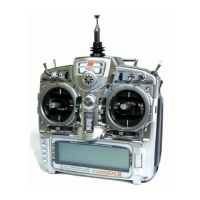General Section 28
Dual Rates and Exponential Curves
Dual Rates and Exponential curves can be very
effective in setting up an aircraft to “feel” the way you
would like it to feel when performing different types of
maneuvers. You can essentially change the aircraft’s
personality just by flipping a switch, causing the aircraft
to take on traits that make certain maneuvers easier for
the pilot. At times you may want the aircraft to feel very
crisp, such as when performing point rolls and sided-
loops and then feel softer for other maneuvers, such as
rolling circles and consecutive rolls, and yet other times
when you would like the aircraft to be very crisp but
without a the tendency to be over-controlled, like in
performing snap rolls. Dual Rates and Exponential
curves can be combined to produce these traits for
most any aircraft. When programming a Dual Rate and
Exponential curve, always think about what kind of
maneuver or flying style you plan to accomplish with it.
Dual Rates (D/R) limit how far a control surface travels.
Without dual rates your control surfaces deflect to their
full travel – the travel that you previously established
with the TRVL ADJ. function and linkage setup. When a
D/R is programmed, it limits the amount of deflection
that occurs when the stick is moved to its extremes. For
example, if you set an Elevator D/R to 75%, the
Elevator will only deflect 75% or 3/4 of its full travel; if
set to 50%, it will be limited to ½ of its full travel; and so
forth. A D/R setting of 100% results in full travel again,
as though there were no D/R programmed at all.
An example of programming a D/R for the Ailerons
would be to set up an Aileron D/R for flying consecutive
rolls by setting the Aileron D/R to 25% (actual
percentage will vary). At this setting, moving the Aileron
stick full left or full right would result in a roll rate of
about 1 roll per second. This allows you to deflect the
Aileron stick all the way and just hold it there while
concentrating on Elevator and Rudder inputs – flying
consecutive rolls just became easier.
EXPONENTIAL (EXP) does not limit the total deflection
of a servo/control surface – the surface still moves
100% of its travel. It does, however, determine how the
surface reaches its full travel, or how the control surface
moves relative to the stick. When Exponential is not
used, the servo response is said to be linear. That is,
every movement of the stick causes the same
movement in the servo--if the stick moves 20%, the
servo moves 20% and the control surface follows the
stick throughout the entire travel range. When plotted
on a graph where the X-axis (left and right) = stick
movement and the Y-axis (up and down) = servo
movement, the result is a straight line that is at 45
degrees.
When using Exponential, a positive (+) exponential
percentage causes the servo to move less when the
stick is close to the neutral point, and to move more as
the stick moves further from the neutral point. For
instance, the stick is moved from neutral to 30% and
the servo only moves from neutral to 10%. As the stick
is moved further from center (from 30% to 50%), the
servo moves further and faster (from 10% to 35%). The
further the stick is moved away from center, the higher
the rate of servo movement. The larger the positive (+)
Exponential percentage, the further the stick must be
moved from center before the servo rate increases, and
the faster the servo rate becomes when it gets close to
the end of its travel. When stick travel (left and right)
versus servo travel (up and down) is plotted on a graph,
the result is a “curve.” The curve stays close to the X-
axis at the center (small servo movement) and moves
away from the X-axis at a greater rate (more servo
movement) as the stick is moved further off center.
Exponential is typically used to reduce sensitivity or
otherwise dampen movements around the neutral stick
position without sacrificing full servo travel. This
provides the pilot with very smooth and precise control
of the aircraft while allowing relatively large movements
in the control stick. It becomes easier to make very
smooth and precise corrections that are difficult to
detect.
If negative exponential is used, it has the opposite
effect. Servo travel is increased around center and
slows towards the ends. Care must be taken with
negative exponential, as an aircraft that is already
overly sensitive may become uncontrollable with
negative exponential. It can prove useful, however,
when hovering a 3D type aircraft.

